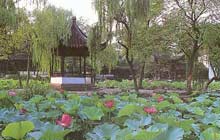
 Renowned for its numerous gardens and canals, Suzhou is frequently mislabeled as the "Venice of the East". Its size and trading volumes though once significant nonetheless do not warrant such a grandiose comparison. Rather, it is best to think of Suzhou as the most distinguished of a multitude of canal towns, dotted around the Yangzi delta.
Renowned for its numerous gardens and canals, Suzhou is frequently mislabeled as the "Venice of the East". Its size and trading volumes though once significant nonetheless do not warrant such a grandiose comparison. Rather, it is best to think of Suzhou as the most distinguished of a multitude of canal towns, dotted around the Yangzi delta.
Suzhou's history dates back to the early seventh century BC at which time the semi-mythical ruler, He Lu, of the Kingdom of Wu is said to have founded the city. With the completion of the Grand Canal during the Sui dynasty (581-618 AD), Suzhou became a thriving commercial district as items such as silk were transported along the bustling waterways. Marco Polo recorded that its populace was comprised of "prudent merchants, and, as already observed, skilful in all the arts. They have also many persons learned in natural science, good physicians, and able philosophers."
During the Ming dynasty (1368 – 1644) with the increased concentration of silk manufacture here, Suzhou became an ever more fashionable cultural center. Thus by 1794, one of the members of Lord Macartney's ill-fated embassy to China described the town as having "(ruling) Chinese taste in matters of fashion and speech, and is the meeting place of the richest pleasure-seekers and gentlemen of leisure in China."
The city's good fortune ran out during the 1860's due to its occupation in the Taiping rebellion and then again in World War II by the Japanese. Today however, Suzhou is regaining its reputation for leisure as its visitors are afforded the rare opportunity to wander through the ancient gardens and homes of aristocrats, scholars and merchants. It is said that at one time, there were more than two hundred gardens in Suzhou. While not all of these still exist, some of the more famous such as those of the Humble Administrator and the Master of the Nets have been restored to their former beauty.
More recently, the city has been undergoing a new transformation. A Singaporean consortium, with the contribution of I.M. Pei, a Suzhou native, has helped to revive Suzhou's original architectural facade. Once more, Suzhou offers a parade of traditional white buildings and cobble-stoned walkways, lined with trees and flowering plants.
A further modern addition, indicative of the ingenious planning being invested in the city's renovation, is the newly built Sheraton Hotel. We will stop here for a dimsum lunch to admire the creative synthesis of traditional Chinese design with the demands of a modern luxury hotel.